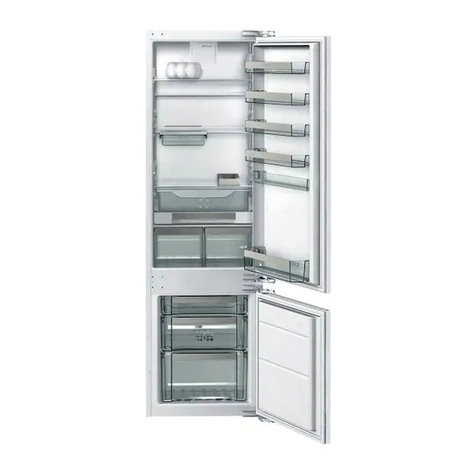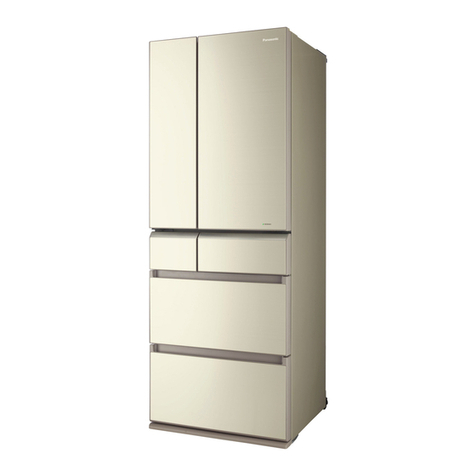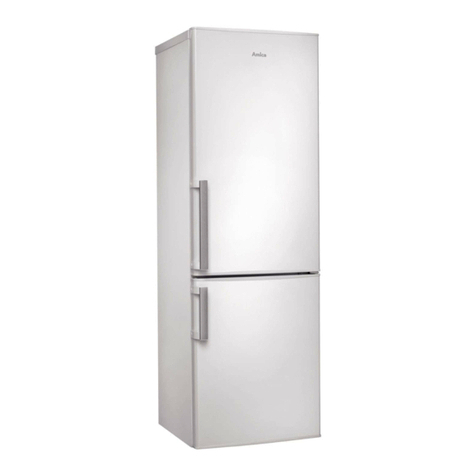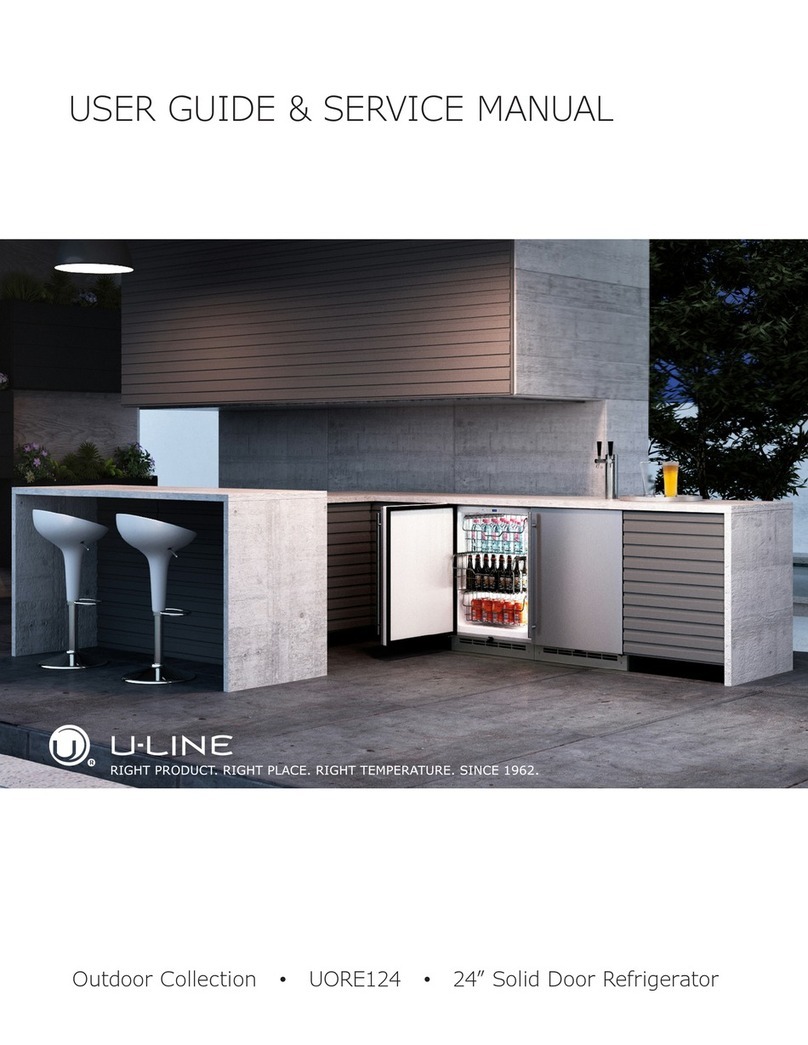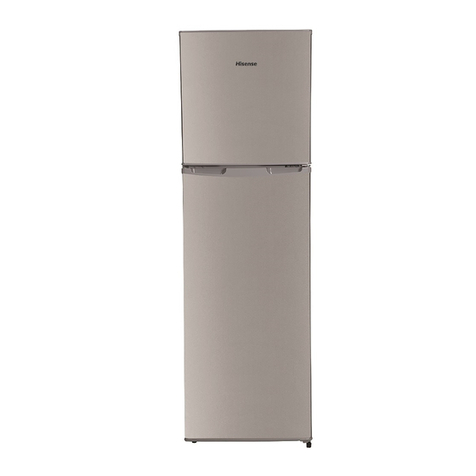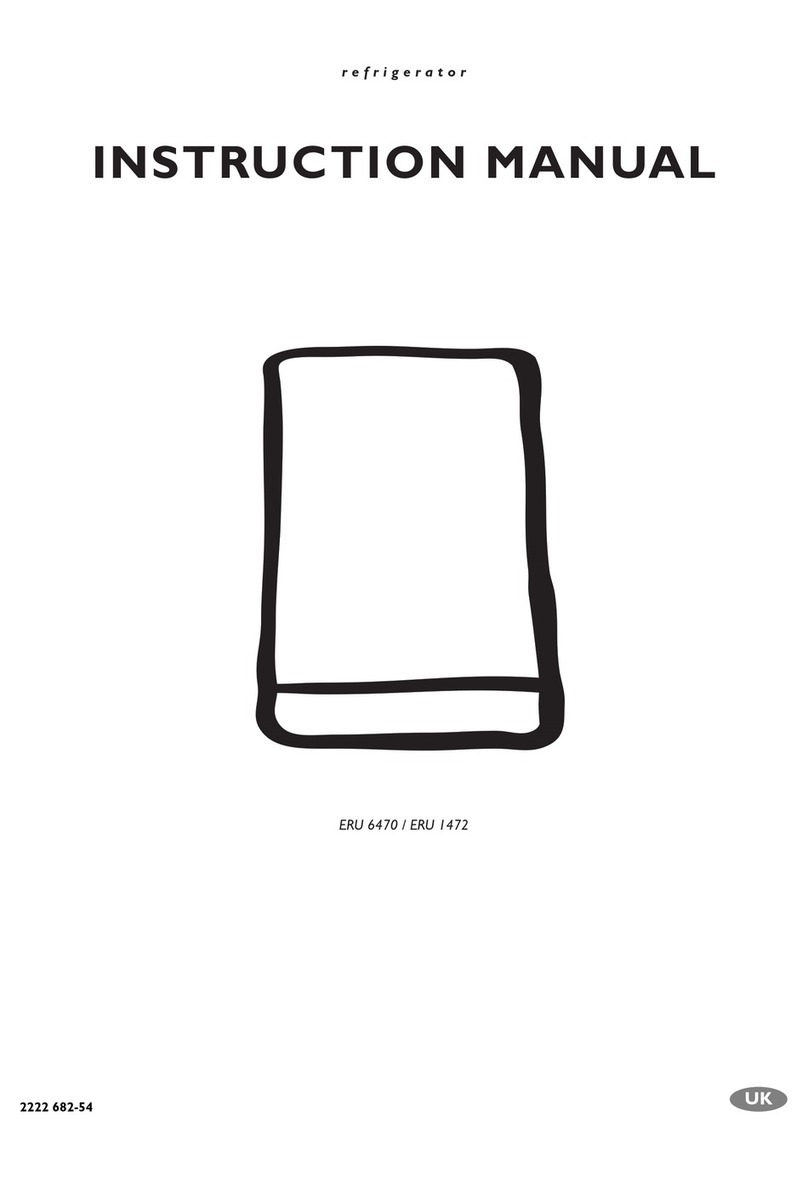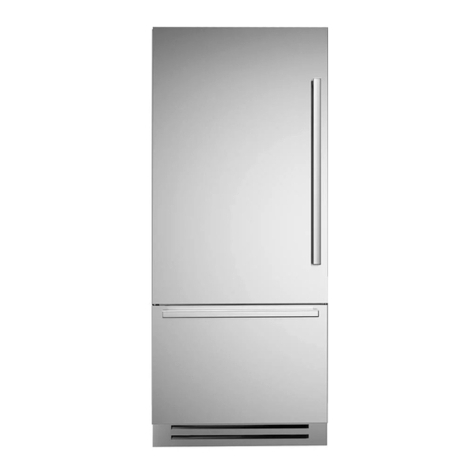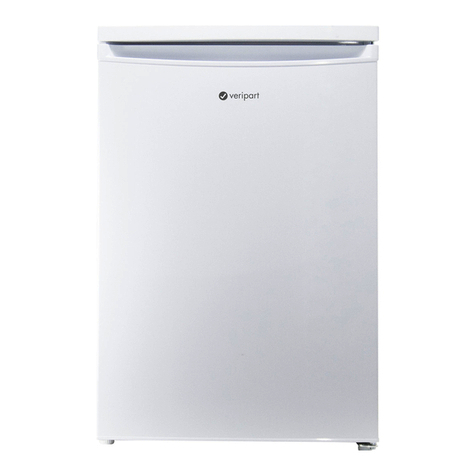Gorenje Plus GDR67088B User manual

Instructions for use GDR67088B
GDR67102B
GSR27178B
GDR67122B
GDR66122BZ
GDR67122FB


479390
Thank you for your confidence in buying our appliance and congratulations on the excellent choice.
We hope it will successfully serve its purpose for many years.
The appliance is intended solely for household use.
The lower part is the refrigerator intended for storage of fresh food at temperatures higher than
0°C.
The upper part is the freezer intended for freezing fresh food and long-term storage of frozen food
(up to one year, depending on the type of food). This compartment is marked with four asterisks.
Before first operation.................................................. 4
A few tips on how to save power with your
refrigerator-freezer combo ........................................ 5
Appliance description................................................. 6
Installation and connections...................................... 8
Changing the door opening direction ....................... 9
Appliance with electronic control............................ 10
Refrigerator interior equipment ............................... 14
Storage of food in the refrigerator........................... 16
Storing food in the Zero+ compartment.................. 17
Storing food in the Fresh+ compartment................ 19
Freezing and storing frozen food............................. 20
Defrosting the appliance........................................... 22
Cleaning the appliance ............................................. 23
Troubleshooting guide.............................................. 24
Noise level.................................................................. 26
3
Refrigerator-freezer

479390
• The appliance is manufactured in compliance with all relevant safety standards; however, it is
recommended that persons with impaired physical, motional, or mental abilities, or persons with
inadequate experience and knowledge, do not use the appliance without due supervision. The
same recommendation applies to minors using the appliance. Cleaning and user maintenance
shall not be made by children without supervision.
• Before connecting the appliance read these instructions carefully. They describe the appliance
and provide instructions for its safe and correct use. The instructions are prepared for different
types and models of the appliance so they may contain descriptions of functions and
components your appliance may not have.
• Remove the wrapping protecting the appliance during transport.
• Wrappings contain environmentally friendly materials which can be recycled, recovered or
disposed off without threat to the environment.
• On the door corners (on freestanding appliances) or on the housing of the appliances (on built-in
appliances) the spacers are installed, which should be removed and replaced with the attached
spacer-plugs.
• Before connecting the appliance to the mains supply, leave it in upright position for about
2 hours. This will reduce possibility of malfunctions in the cooling system resulting from prior
transport and handling.
• The appliance must be connected to the mains supply in accordance with the standing
regulations and local requirements.
• The appliance must not be used in open air or exposed to weather precipitation.
• Always disconnect the appliance from power supply (pull the power cord from wall socket) before
cleaning and before replacing the light bulb.
• If the power supply cord is damaged, in order to avoid hazard it must be replaced by the service
or by qualified personnel.
• If the LED lighting no longer works, call an authorized Gorenje service technician.
• In case of longer disuse first turn the appliance off with the ON/OFF button and disconnect it
from mains supply. Empty the appliance, clean the interior and leave the door ajar.
• For the protection of environment deliver the obsolete appliance to the authorized scrap
appliance dealers.
• Never let the children play with the appliance.
• Self closing shear door hinge pulls the door to the cabinet just before closing, thereby preventing
the door to remain ajar. Equally it limits the door opening angle and prevents damage to adjacent
elements.
• Rating plate with basic information is located in the interior of the appliance. If the sticker plate is
not suitable for your language, replace it with the attached one.
• Warning: Ventilation slots on the appliance or built-in
element should always be kept clean and unobstruc-
ted.
• Warning: Do not use any mechanical accessories
when thawing the refrigerator, except for those explici-
tly recommended by the manufacturer.
Before first operation
4

479390
• Warning: To prevent any pollution be careful not to
damage the insulation or refrigeration tubes at the rear
wall during the installation, cleaning and disposal of the
appliance.
• Warning: Do not use any electrical devices inside the
appliance, except for those explicitly recommended by
the manufacturer.
The symbol on the product or on its packaging indicates that this product may not
be treated as household waste. Instead it shall be handed over to the applicable
collection point for the recycling of electrical and electronic equipment. By ensuring
this product is disposed of correctly, you will help prevent potential negative consequences
for the environment and human health, which could otherwise be caused by inappropriate
waste handling of thisproduct. For more detailed information about recycling of this product,
please contact your local city office, your household waste disposal service or the shop
where you purchased the product.
• Observe the installation instructions.
• Do not open the appliance door more frequently than necessary.
• Occasionally check whether air can circulate freely behind the appliance.
• Condenser unit mounted on the appliance back wall must be kept clean at all times (see section
“Cleaning the appliance”).
• If the seal is damaged or loose, replace it as soon as possible.
• Store your food in closed containers or other appropriate packaging.
• Before placing the food in the refrigerator, let it cool down to room temperature.
• Defrost your frozen food in the refrigerator compartment.
• Remove the freezer drawers and door as described in the instructions, in order to make use of
the entire capacity.
• Defrost your conventional freezer when a frost layer approximately 3-5 millimetres thick has
accumulated on the surfaces in the freezer compartment.
• Make sure the shelves are evenly distributed and that the food is arranged in a way that
allows free circulation of air (heed the recommended food arrangement as described in the
instructions).
• In appliances fitted with a fan, do not block the fan slots.
5
A few tips on how to save power with your
refrigerator-freezer combo

479390
Appliance interior equipment may change according to the appliance model.
6
Appliance description

479390
A. Refrigerator
B. Freezer
1. Fan
2. Control unit
3. Folding egg tray (closed for 6, open for 12
eggs)
4. Bottle rack
5. Pull-out glass shelf – short
6. Pull-out glass shelf (height adjustable)
7. Snack+ pull-out drawer for snacks
8. Fresh+ drawer
9. Zero+ drawer
10.Fruit and vegetable bins
11. Crisp+ fruit and vegetable bins
12.Refrigerator door bin (deep, shallow)
13.Bottle shelf with retainer
7

479390
• Place the appliance in dry and well aired room. The appliance
operates best at temperature ranges indicated in the chart
below. Relevant class of the appliance is indicated on the
rating plate.
Class Ambient temperature
SN (subnormal) from + 10°C to + 32°C
N (normal) from + 16°C to + 32°C
ST (subtropical) from + 16°C to + 38°C
T (tropical) from + 16°C to + 43°C
Positioning the appliance requires two persons in order to avoid
injuries or damage to the appliance.
• Place the appliance flatly and firmly on a solid base.
• Avoid exposing the appliance to direct sunlight or heat
sources. If this is not feasible, install insulation plate between
the appliance and adjacent heat source.
• Be sure to leave enough space for cooling of condenser
(distance from the wall or the opening should be 200 cm2).
Distance to the cabinet above the appliance should be at least
5 cm.
After the installation, the appliance mains plug should be
accessible!
Warning: when installing built-in appliances into a cupboard or
cabinet in a side-by-side layout, the dew prevention installation
kit should also be purchased and installed. For safety reasons,
dew prevention kit may only be installed by an authorized
service technician!
Order code: 376078 (appliances higher than 1,700 mm)
• Use the power cord to connect the appliance to the mains
power. Wall outlet must be fitted with ground terminal (safety
socket). Required nominal voltage and frequency are indicated
on the relevant label or rating plate of the appliance.
• Mains power connection and grounding must be made in line
with standing regulations and local requirements.
The appliance is able to accommodate minor temporary voltage
tolerances, but they may not exceed -6% to +6%.
Selecting the location
Positioning the
appliance
Connecting to power
supply
8
Installation and connections

479390
1. Undo the latch A and door hinge B of the low temperature
compartment and remove the door C.
2. Rotate the door by 180°, mount them on the other side of the
low temperature compartment, and attach the latch A and
door hinge B to the other side of the cell.
3. Cover the holes left in the cell with the plugs supplied in the
bag.
4. Check the door seal. If the seal does not fully fit the door,
remove it and rotate it by 180°.
Changing the direction
of low temperature
compartment door
opening
9
Changing the door opening direction

479390
CONTROL UNIT I
ATemperature setting and on/off knob
BSignal light: on when the appliance is in operation
C Fan boost key
DSignal light: on when the fan boost is activated
E Super freeze key
F Signal light: on when Super freeze is activated
GDigital refrigerator temperature display indicates actual temperature in the appliance in the
range from +1°C to +9°C (or +3°C to +8°C for appliances equipped with the Zero+ drawer)
A
G
C
D
E
F
B
10
Appliance with electronic control

479390
C
D
E
F
B
A
G
Max 25W
A
G
C
D
E
F
B
CONTROL UNIT II
ATemperature setting and on/off knob
BSignal light: on when the appliance is in operation
C Acoustic alarm off key
D Signal light: flashes when high temperature alarm is activated
E Super freeze key
F Signal light: on when Super freeze is activated
GDigital refrigerator temperature display indicates actual temperature in the appliance in the
range from +1°C to +9°C
11

479390
Switch on the appliance by rotating the Aknob towards the max.
position. To switch off the appliance, align the recess on the knob
with the sign (appliance is still powered - there is still electric
current in the appliance).
• Set the desired refrigerator temperature with the Aknob. The
temperature can be set in the range from min. to max.
• Recommended setting of the thermostat knob is on the eco
position.
• If the temperature of the room in which the appliance is
installed is lower than 16°C or if there is less than 10 kg of
food in the freezer, we recommend setting the thermostat
knob to max. position. The fan should be switched off. This is
required in order to provide adequately low temperature in the
freezer to allow long-term storage of frozen food.
• If the temperature in your home is higher than normal, we
recommend activating the fan boost by pressing the Ckey
(CONTROL UNIT I).
• While the settings are being changed, the display will flash
and an acoustic signal will indicate each change to the set
temperature. When the flashing stops, the most recent setting
is stored in the memory.
• When turning on the appliance, the display Gwill flash
for a few seconds – to show the set value. Then, actual
or maximum value is displayed. In case of the latter, it is
displayed until the temperature in the refrigerator falls below
that value.
• Press the Ckey to activate the fan boost (signal light Dwill
light up - CONTROL UNIT I).
Use this function to reduce condensation (dew) on interior
walls, temperature differences between particular sections of
the appliance, or in case of higher environment temperature.
The fan will only operate when the refrigerator door is closed.
Switching the appliance
on/off
Setting the refrigerator
temperature
Activating the fan boost
C
D
12

479390
• Use this setting after switching on the appliance for the first
time, before cleaning, or when inserting a large amount of
food. Press the Ekey (signal light Fwill light up). The setting
will be switched off automatically after approximately two days.
If refrigerator door is open for more than one minute, an acoustic
alarm will be activated. The alarm is deactivated when the door
is closed.
If the temperature is too high, an acoustic alarm will be activated
(intermittent beep) and the signal light Dwill flash
(CONTROL UNIT II).
• To switch off the acoustic alarm, press the Ckey. Signal light D
will go off automatically as soon as the temperature drops to a
level that no longer presents spoilage hazard.
• If the temperature has not dropped sufficiently in 24 hours
after the alarm was deactivated, the acoustic alarm will be
reactivated. The alarm will be switched off automatically
as soon as the temperature drops to a level that no longer
presents spoilage hazard.
• When the appliance is switched on for the first time, there
is a 24-hour delay in temperature alarm operation since the
appliance will not have reached the adequate temperature.
Thus, unnecessary activation of alarm is prevented.
Super freeze function
Open refrigerator door
alarm
High refrigerator
temperature alarm
13

479390
(Equipment depends on the model)
• The shelves may be adjusted as you like using the guides in
the refrigerator interior.
• Each shelf is fitted with a locking device at the back, which
prevents it from being pulled out unintentionally.
If you wish to pull out a shelf (to move to another position or
for cleaning), please proceed as follows:
1. lift the rear end of the shelf;
2. pull out the shelf along the guides at the sides as far as the
door;
3. rotate the shelf upwards or downwards, depending on the
position of the lighting device.
To replace the shelf, follow the procedure in reverse.
Store perishables at the back of the shelf where the temperature
is lower.
• Bottle rack can be placed on any shelf in the refrigerator.
When placing the rack, make sure the bottles to not obstruct
the door. The rack can be used elsewhere as well, e.g. as a
convenient holder for bottled beverages stored at room
temperature.
• The bin at the bottom of the refrigerator, under the glass shelf,
is intended for storing fruit and vegetables. It provides humidity
and prevents the food from drying out.
Shelf
Bottle rack
Bin
14
Refrigerator interior equipment

479390
• Mounted on the refrigerator door are compartments (shelves
or bins) intended fro storing cheese, butter, eggs, yoghurt and
other smaller packages, tubes, cans, etc. There is a bottle
shelf at the lower end of the door.
• The fan is located under the ceiling or behind the back wall of
the refrigerator compartment (or concealed in the freezer unit)
to allow more even distribution of temperature and to reduce
condensation on the storage area.
• This box with a special closing mechanism is ideal for
storing food such as cheese, salami, bread spreads, pâté,
sandwiches, butter, and other snacks. In this container, the
food will not dry out; moreover, the box can be removed from
the refrigerator and used to serve the food stored within. It is
mounted under a glass shelf on a slider that allows moving it
to the left or right as necessary to make the best use of the
remaining space underneath.
Sections of the refrigerator:
- upper part: canned food, bread, wine, pastry etc.
- middle part: dairy products, ready-made meals, desserts, soft
drinks, beer, cooked food, etc.
- lower part: meat, meat produce, delicatessen;
- vegetable bin: fresh fruit, vegetables, salads etc. In appliance
without the Zero+ drawer, also root vegetables, potatoes,
onions, garlic, tomatoes, tropical fruit, sauerkraut, turnips etc.
- Zero+ drawer: fresh meet, meat produce, fish, seafood, dairy
products, salads, fruit, vegetables, mayonnaise, sauces etc.
Sections in the refrigerator compartment door:
- upper/middle door shelf: eggs, butter, cheese;
- lower door shelf: beverages, cans, bottles, etc.
Freezer compartment:
- upper shelf position: for freezing (only with some models)
- lower shelf position: for storage (only with some models)
Interior side of the
refrigerator door
Fan
Snack+ pull-out drawer
for snacks
Recommended
distribution of food in
the appliance
15

479390
• Proper use of the appliance, adequately packed food, correct
temperature and hygienic precautions produce substantial
impact on the quality of stored food.
• Always respect the best before date, printed on the packaging.
• Food to be stored in the refrigerator should be properly packed
as to prevent emission and/or reception of moisture and odors.
• Never store inflammable, volatile or explosive substances.
• Beverages with high alcohol percentage shall be stored in
tightly sealed bottles in vertical position.
• Some organic solutions like volatile oils in lemon or orange
peel, acids in butter etc. can cause damage in prolonged
contact with plastic surfaces or gaskets for longer period of
time they can cause accelerated aging of the plastic material.
• Unpleasant odor inside the refrigerator is a sign that something
is wrong with food or that your refrigerator needs cleaning (see
chapter Cleaning).
• If you plan a longer absence, make sure you removed quickly
perishable articles of food from the appliance before you
leave.
Recommended periods of storing fresh food in the
refrigerator
Food Storage period
eggs, marinades, smoked meat, up to 10 days
cheese up to 10 days
carrots, etc… up to 8 days
butter up to 7 days
cake, fruit, TV-dinner dishes, raw chunks
of meat up to 2 days
fish, raw minced meat, seafood up to 1 day
Important precautions
and hints
Storage periods
16
Storage of food in the refrigerator

479390
In the Zero+ compartment, food stays fresh three times as long as
in a conventional refrigerator, retaining more flavour and nutrients.
Decay and loss of mass are slowed down; therefore, fruit and
vegetables remain fresh and natural longer.
Storage temperature is around 0°C (preset). According to the
temperature changes in the refrigerator, actual temperature may
be between -2°C and +3°C. If the temperature of the room where
the appliance is installed is below 16°C, we recommend setting
the refrigerator compartment temperature to 4°C or lower. For
optimum performance, the drawer should be fully closed.
• When you buy food check its freshness: quality and durability
of food depends on it.
• Store your food in closed containers or appropriate packaging
to prevent it from emitting or receiving odours and moisture.
• Approximately 30-60 minutes prior use remove food from
the drawer to let its aroma and taste develop at ambient
temperature.
• Food sensitive to low temperatures is not suitable for storage
in the Zero+ drawer: pineapple, avocado, bananas, olives,
potato, eggplant, cucumber, beans, bell pepper, melons, water
melons, pumpkins,...
17
Storing food in the Zero+ compartment

479390
Type of food Time
Sausages, cold cuts, beef, pork, venison,
raw meat up to 7 days
poultry up to 5 days
fish up to 4 days
seafood up to 3 days
Vegetables:
cabbage, garlic, carrots up to 180 days
celery, herbs up to 30 days
lettuce, cauliflower, radicchio, rhubarb up to 21 days
broccoli, asparagus, savoy, Chinese cabbage
kohlrabi, radish up to 14 days
onions, mushrooms, spinach, peas up to 7 days
Fruit:
apples up to 180 days
pears, kiwi up to 120 days
grapes, quince up to 90 days
peaches up to 30 days
blackcurrant, gooseberry, plums up to 21 days
apricots, blueberries, cherries up to 14 days
raspberries, strawberries up to 3-5 days
Other:
milk up to 7 days
butter up to 30 days
cheese up to 30 days
* depending on quality and freshness of food
18
Approximate storage
time in the Zero+

479390
The Fresh+ drawer allows storing a wide variety of fresh food to
keep longer than in a conventional refrigerator. The food stays
fresh longer, retaining the flavour and nutrients.
It lows down decay and loss of mass; therefore, fruit and
vegetables remain fresh and natural longer.
For optimum performance, the drawer should be fully closed.
• When buying food, make sure it is fresh as this will determine
the quality of the food, as well as how long it will keep in the
fridge.
• Store your food in closed containers or appropriate packaging
to prevent it from emitting or receiving odours and moisture.
• Take the food from the drawer 30-60 minutes before use to
allow the aroma and flavour develop at room temperature.
• Food sensitive to low temperature and not appropriate for
storage in the Fresh+ drawer include the following: pineapple,
avocado, bananas, olives, potatoes, eggplant, cucumbers,
beans, peppers (capsicum), melons, watermelons, pumpkins
and squash, etc.
• To remove the drawer:
- remove the vegetable bin;
- remove the glass shelf above and, with some models, under
the FreshZone drawer;
- if necessary (with some models), remove the drawer door
(1): open, hold in the middle (as shown in the figure), bend
slightly and simultaneously pull up towards you;
- pull out the drawer to the position indicated in the figure
(detail »A«), rotate it downwards and remove it.
- To replace the drawer, observe the reverse order.
19
Storing food in the Fresh+ compartment

479390
• Activate the super freeze function 24 hours before freezing
fresh food:
- control unit I and II: press the Ekey (signal light Fwill light
up).
After that, distribute the food evenly across the shelf in the upper
position, making sure they are not in contact with the already
frozen food packages. In appliances without the shelf, place the
food on the bottom, closer to the front.
• After 24 hours you may relocate the food to the storage
compartment, and repeat the freezing procedure if required.
• For freezing smaller quantities of fresh food (1-2 kg), the
engagement of the fast freeze function is not required.
• Freeze only such food which is suitable for freezing and sustain
low temperatures. Food should be of adequate quality and
fresh.
• Select adequate packaging for each kind of food and pack it
correctly.
• The packaging should be air tight and well sealed without
leaking since this could cause substantial vitamin loss and
dehydration.
• Mark packages with following data: kind and amount of foods
and the date of loading.
• It is imperative that food is frozen as quickly as possible. We
therefore recommend the size of the package not to be too
large and to be cooled before loading into the freezer.
• The amount of the fresh foods that can be loaded in the freezer
as a single load is declared on the rating plate. If the loaded
amount is too large, the quality of freezing is reduced which in
turn affects the quality of frozen foods.
The storage time and recommended temperature for storing
commercially frozen foods is indicated on the packaging. Always
follow manufacturer’s instructions for storage and use of frozen food.
When shopping be careful to choose only food which is adequately
packed and provided with complete data and stored in freezers where
the temperature never rises above -18°C.Do not buy packages of
food wrapped with frost. This indicates that the package was thawed
before at least once. Take care that packages don’t start to thaw
during transport to your home. Temperature rise shortens the storage
time and affects the quality of commercially frozen foods.
Freezing procedure
Important precautions
and hints for freezing
fresh food
Storage of industrially
frozen food
20
Freezing and storing frozen food
This manual suits for next models
5
Table of contents
Other Gorenje Plus Refrigerator manuals
Popular Refrigerator manuals by other brands

KitchenAid
KitchenAid KSC23C8EYY installation instructions
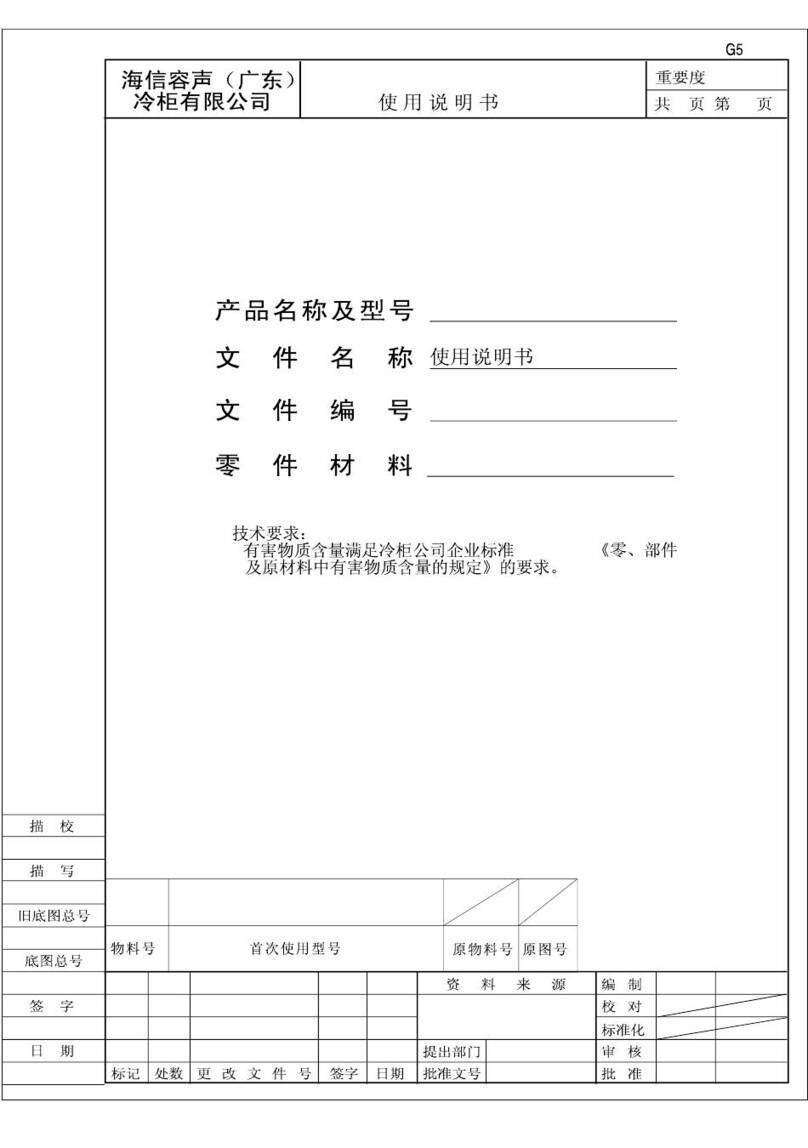
Hisense
Hisense HSC-192FLB Operation manual
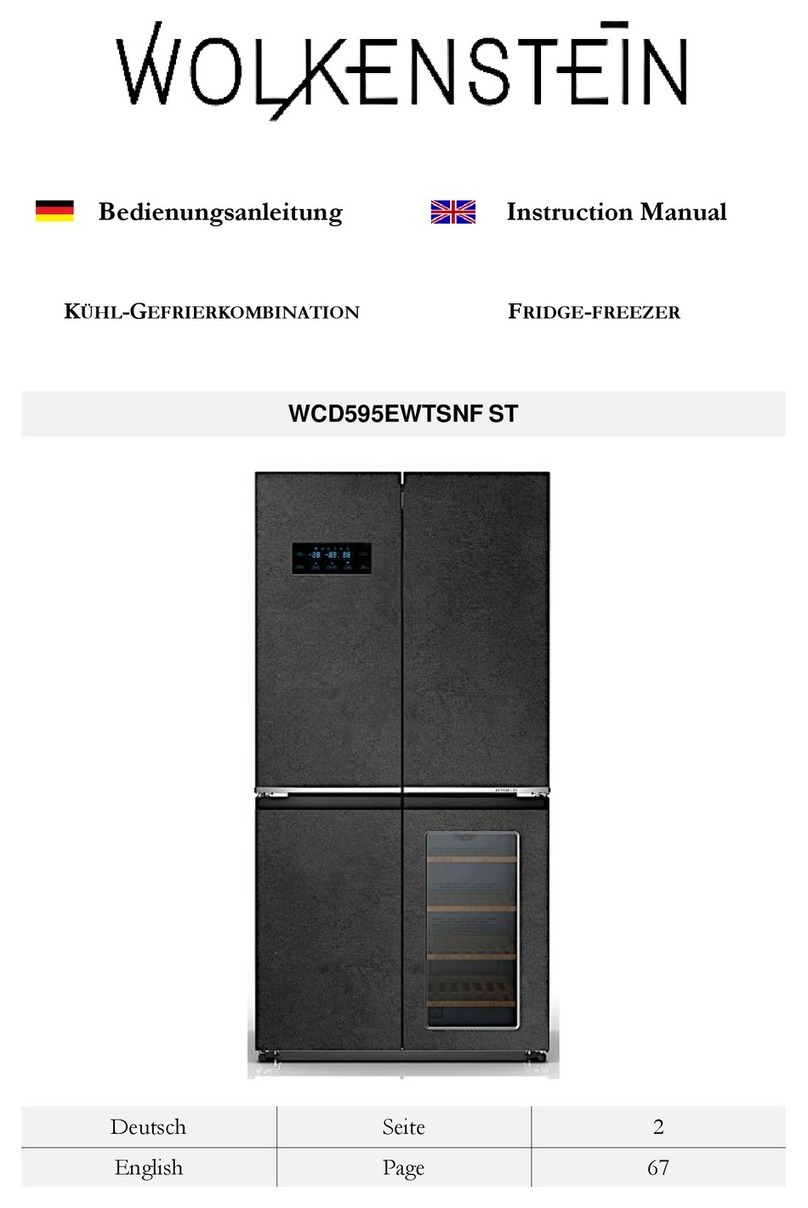
Wolkenstein
Wolkenstein WCD595EWTSNF ST instruction manual
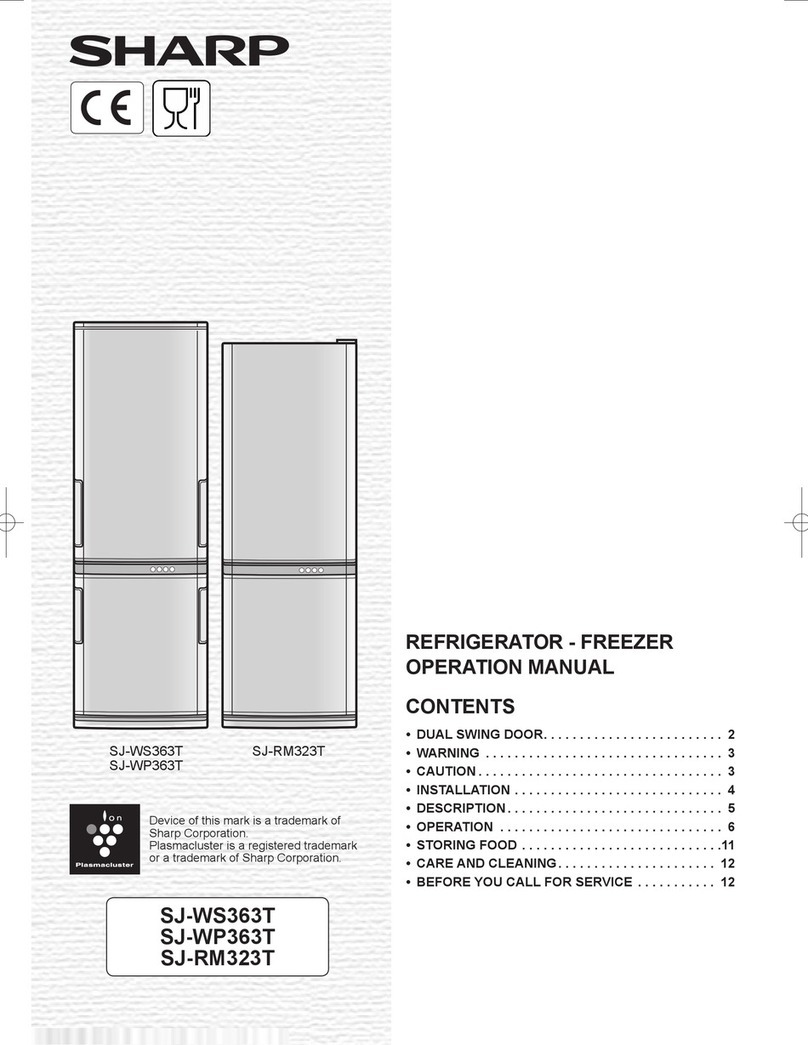
Sharp
Sharp SJ-WS363T Operation manual
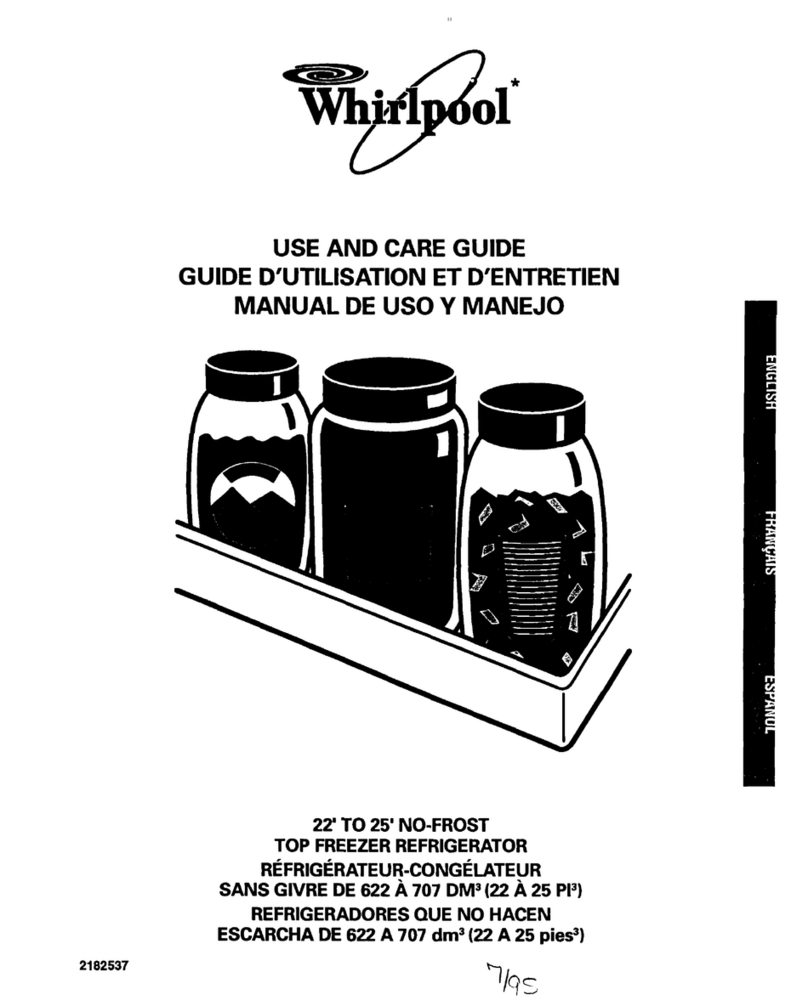
Whirlpool
Whirlpool ET22PKXDN00 Use and care guide
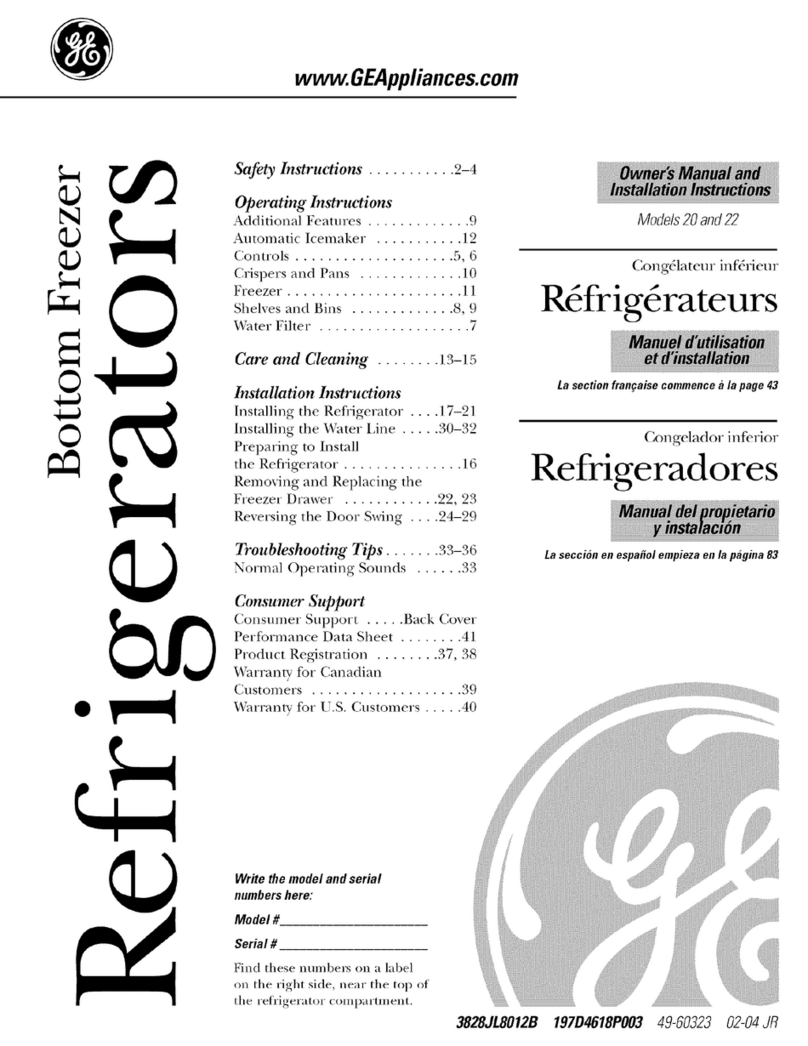
GE
GE Model 20 Owner's manual and installation instructions
